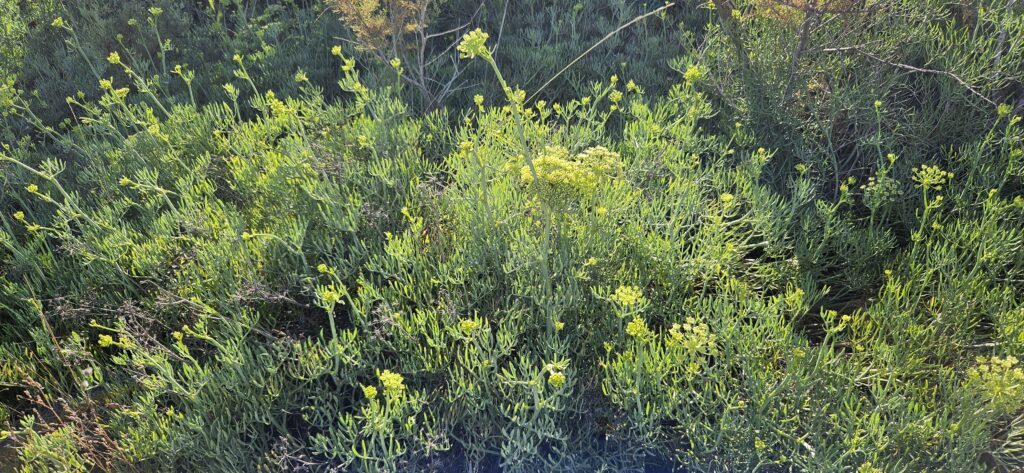
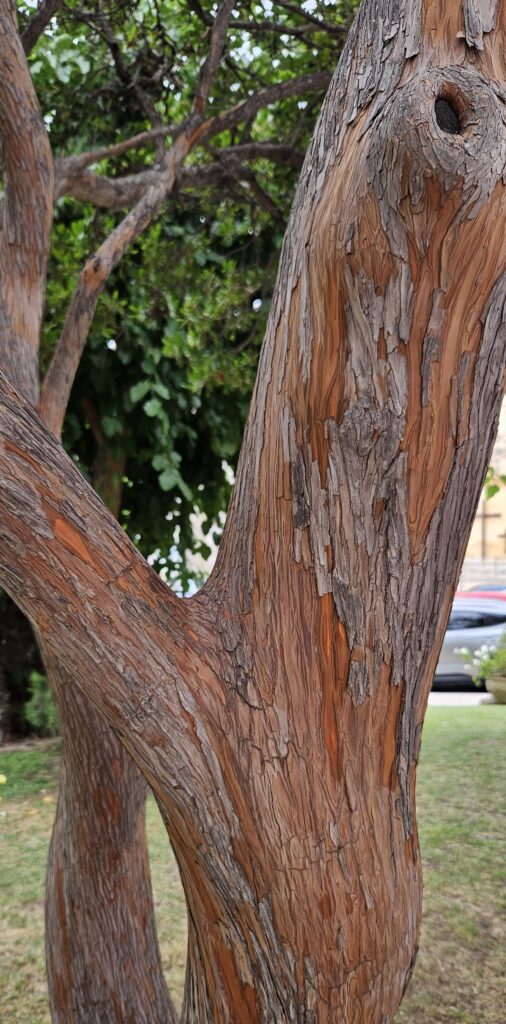
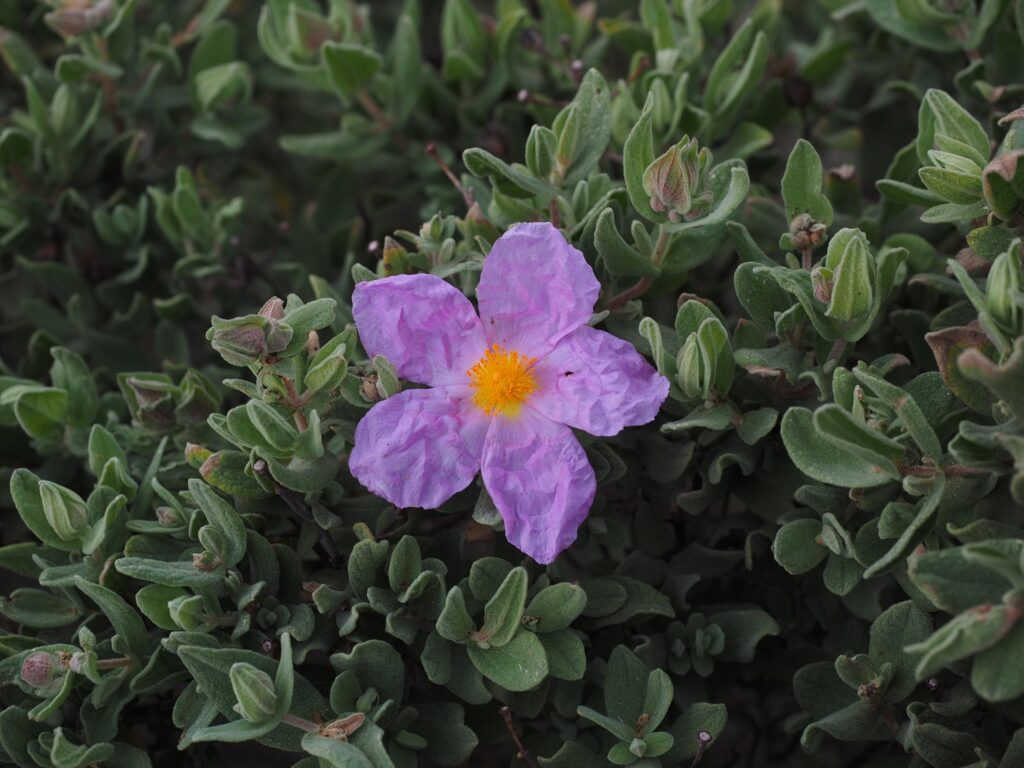
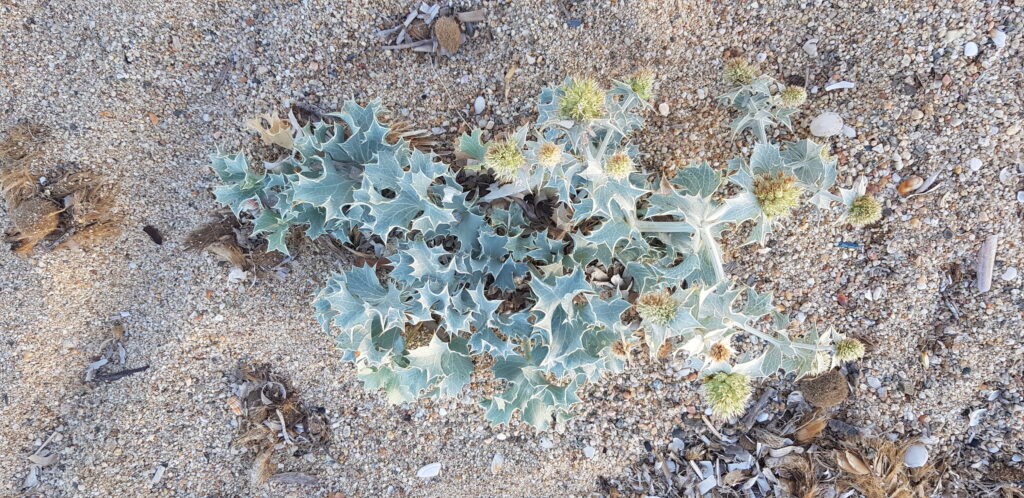
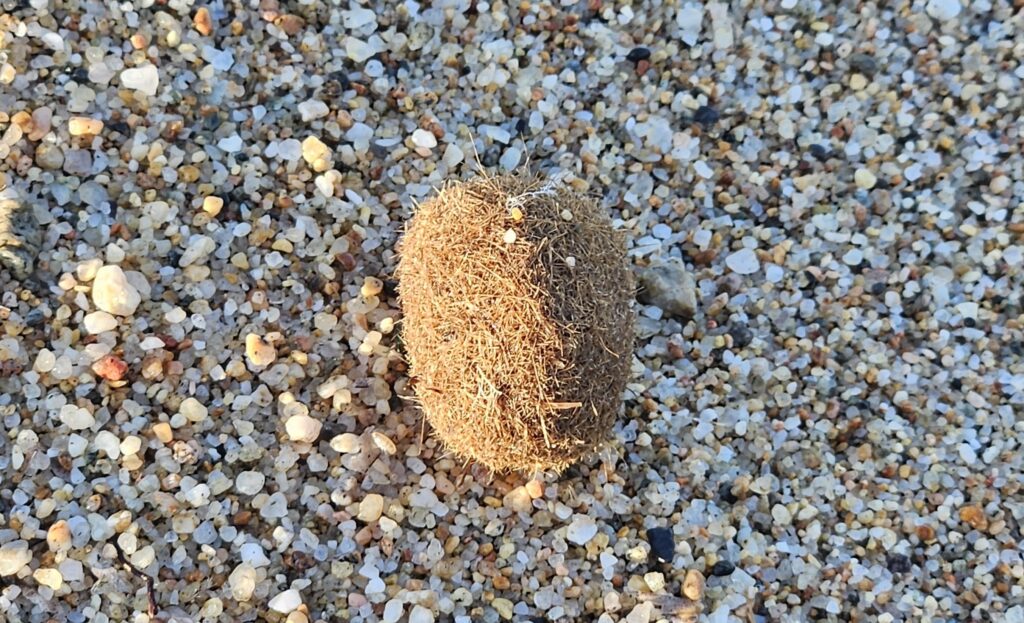
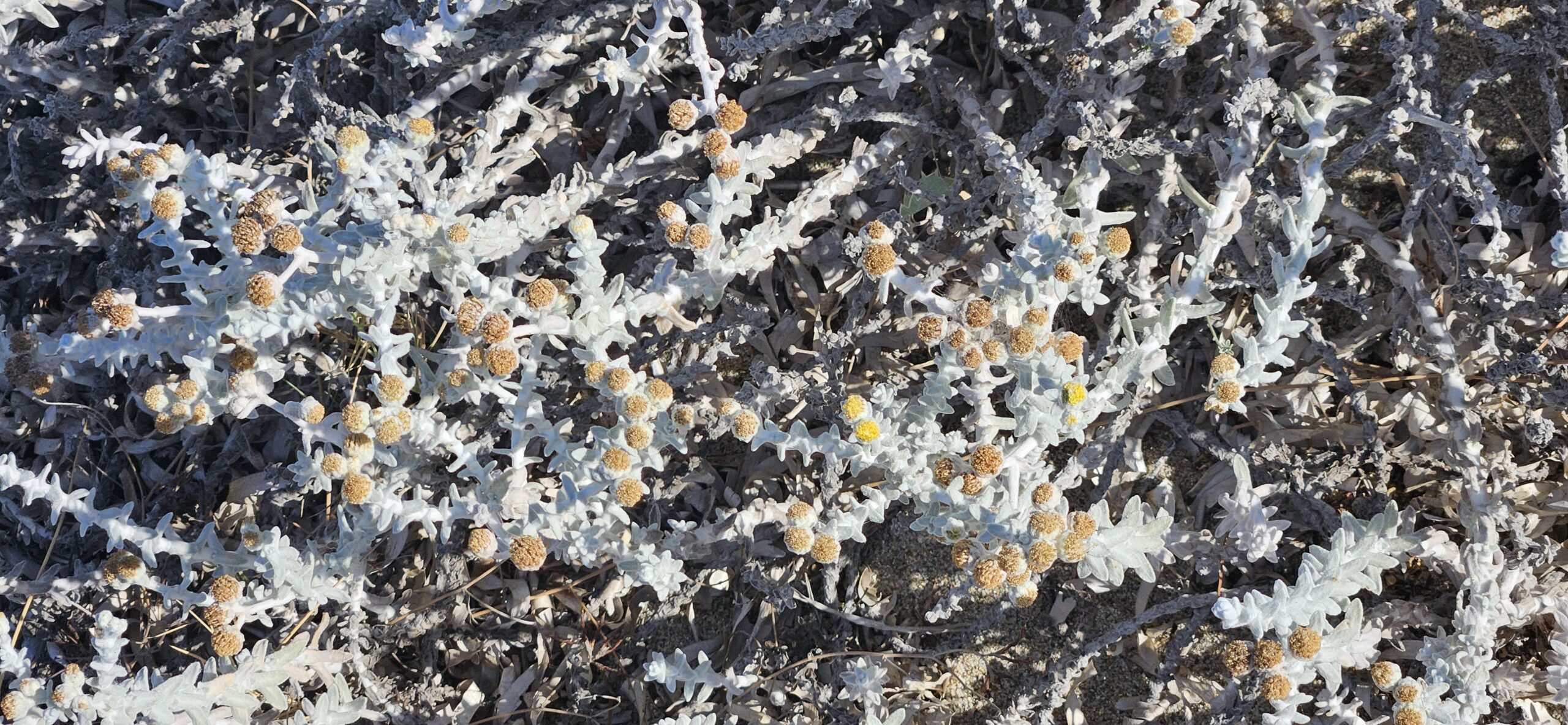
- Almond Tree
- Cactus
- Carob Tree
- Coastal and Beach Plants
- Eucalyptus Tree
- Fig Tree
- Flowering Shrubs
- Juniper
- Maquis
- Mastic
- Mediterranean Herbs
- Mediterranean Strawflower
- Myrtle
- Oak Tree
- Olive Tree
- Pine Tree
- Purslane
- Rockrose
- Strawberry Tree
Flora of Sardinia
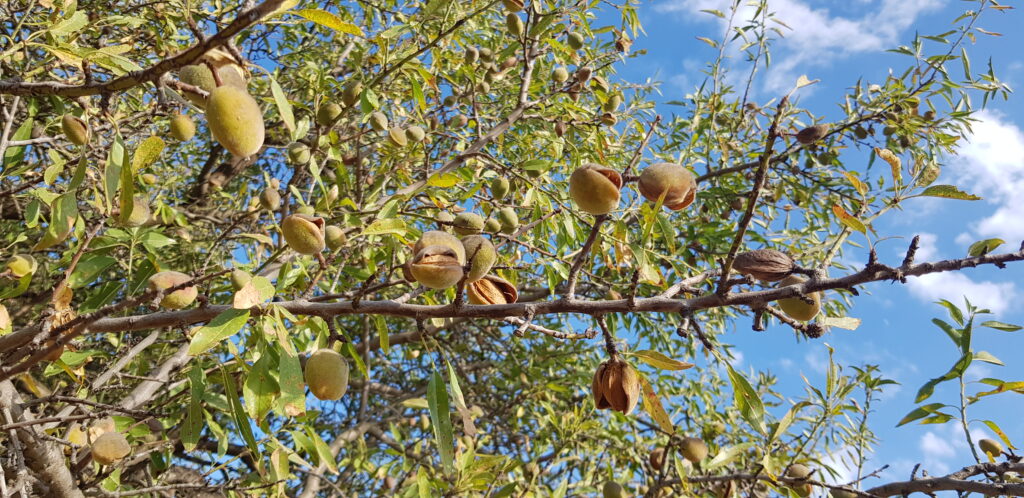
Almond Tree
At first glance, we didn’t even recognize the almond trees: the green-brown fruit husks, in which the almond kernels mature, initially looked more like small peaches or apricots.
In Sardinia, mainly sweet almonds (Prunus dulcis var. dulcis) are cultivated. The small, nutritious kernels are rich in vitamins, minerals, and healthy fats. They support heart health, provide energy, and are versatile in the kitchen. Bitter almonds (Prunus dulcis var. amara) are very rare on the island and are generally not eaten directly. Instead, they are used in small amounts as flavoring for baked goods, sweets, liqueurs, and spirits, as well as for medicinal purposes – traditionally included in tinctures and bitters to aid digestion, treat coughs and colds, or in herbal mixtures with soothing or pain-relieving effects.
Cactus
In Sardinia, cacti, especially the prickly pear (Opuntia ficus-indica), are very common. Originally from Mexico, they have become firmly established on the island and are now a typical part of the Mediterranean landscape, particularly along the coasts.
These spiny plants are extremely adaptable and thrive even in dry, rocky areas. They help stabilize the soil, provide shade and shelter for small animals and insects, and thus contribute to biodiversity.
The brightly colored prickly pear fruits are not only visually striking but also edible. They can be eaten fresh, made into jam, or used in drinks. Even the young, fleshy cactus pads, known as nopales, are edible and are often cooked or fried in Mediterranean cuisine.
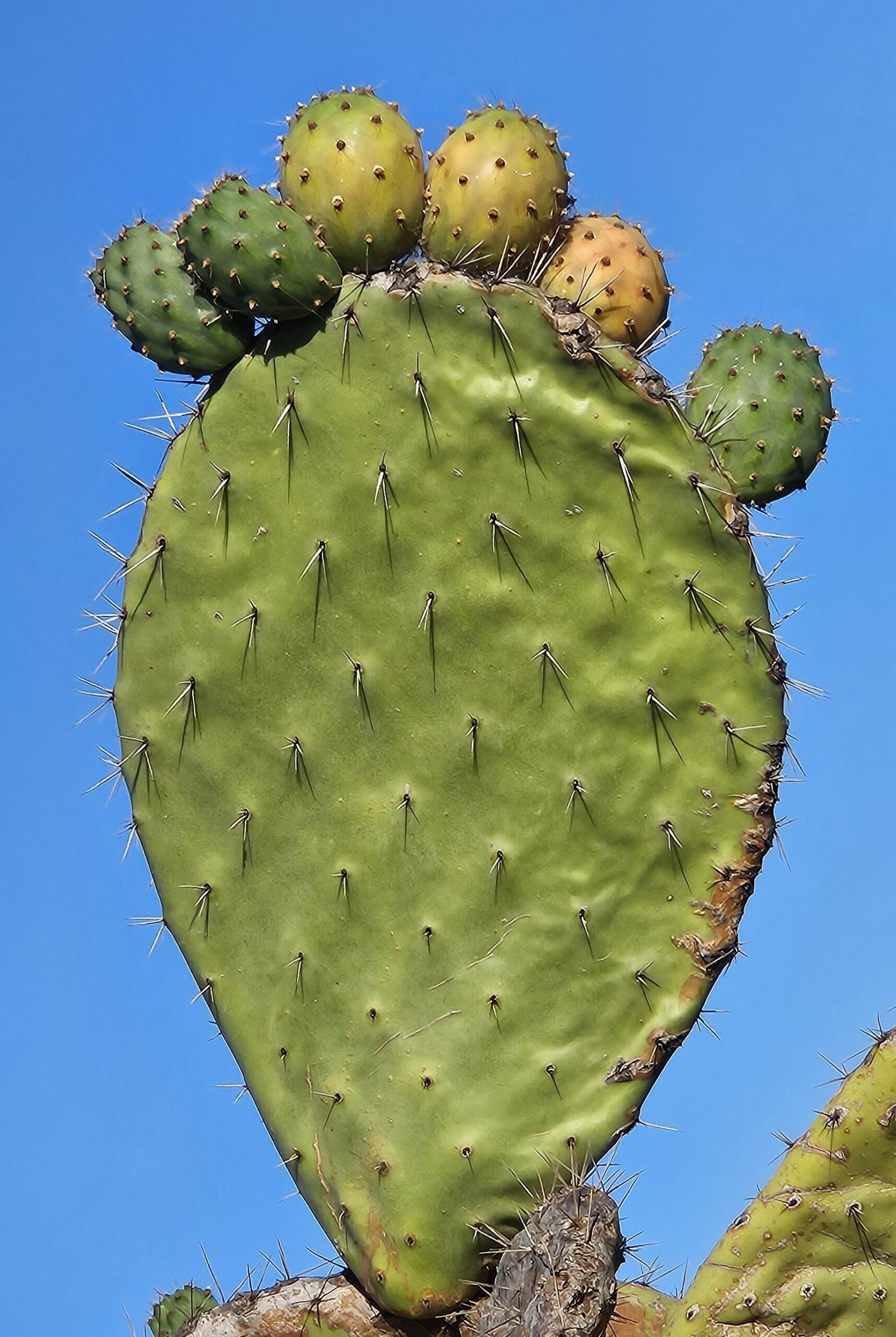
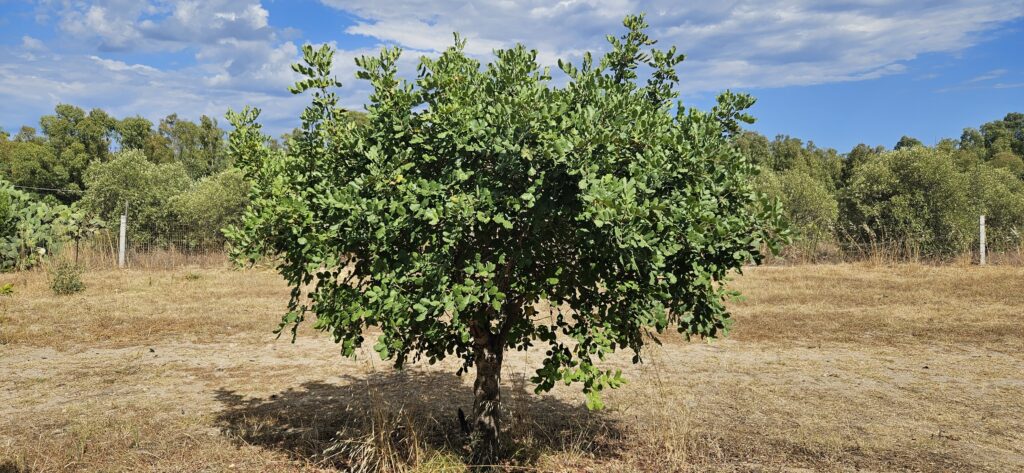
Carob Tree
The carob tree (Ceratonia siliqua) is native to Sardinia and is one of the typical trees of the Mediterranean region. Originally from the eastern Mediterranean and the Near East, the tree has been cultivated throughout the Mediterranean since prehistoric times. Today, it is firmly established in Sardinia and considered part of the traditional cultural landscape.
The tree thrives especially in warm, dry lowlands and coastal areas. In addition to wild stands, there are also small plantations, mainly used for animal feed and human consumption.
The pods or legumes are dried, sometimes roasted, and then ground into powder – this is the well-known carob powder, used in drinks or baked goods as a sweet cocoa substitute. The beans or seeds from the pods, on the other hand, are used to produce locust bean gum or carob bean gum, a plant-based thickening and gelling agent found in many foods.
Not every carob tree produces pods: young trees often need 5-7 years before they bear fruit for the first time. Pollination, climate, and soil conditions also play a role: without enough flowering neighboring trees or under conditions of drought and nutrient deficiency, flowers may fall off before pods develop.
Coastal and Beach Plants
Sea fennel, also known as Samphire (Crithmum maritimum), prefers to grow directly along the coast, often in sandy or rocky areas above the splash zone, and sometimes on cliffs. It is salt-tolerant and typical of Mediterranean shores; in Sardinia, the plant is particularly widespread. Its fleshy, bluish-green leaves bear yellowish-green, umbrella-shaped flower clusters in summer. It is edible, with a slightly salty and spicy-lemony taste, and was traditionally pickled or used as a source of vitamin C on sea voyages.
The sea holly (Eryngium maritimum), also known as the maritime thistle, is commonly found on sandy beaches and in dunes and is typical of Mediterranean regions such as Sardinia. With its spiny blue-green leaves and globular flower heads, it is perfectly adapted to the salty, windy coastal environment. At the same time, its deep roots help stabilize the dune soil.
The snow-white sea yarrow (Achillea maritima, also Otanthus maritimus) is a small but striking beauty of the Mediterranean coasts and a close relative of the well-known yarrow. With its dense, silvery-white, woolly leaves, it almost appears to be dusted with a fine veil of sea salt. This hairiness protects it from intense sunlight, salty spray, and water loss. Growing in sand dunes and windy coastal areas where few plants can thrive, it withstands heat, wind, and drought. From June to September, its small, bright yellow flower heads appear, providing nectar for insects. At the same time, its roots help stabilize the loose sand, thus preserving the delicate dune ecosystem.
What are those brown balls that you often find on sandy beaches – especially near seagrass meadows or after stormy weather – that at first glance look like small coconuts or large droppings?
They are called Neptune balls or Posidonia balls. They form from the dead, fibrous root and leaf remnants of Posidonia oceanica, a seagrass species of the Mediterranean. The waves roll these fibers along the seafloor until they mat together into dense, round or oval, purely plant-based “balls”, which are then washed up on the shore. Neptune balls occur only in the Mediterranean and help protect the coastline from erosion by trapping sand when they accumulate in large numbers on the beach.
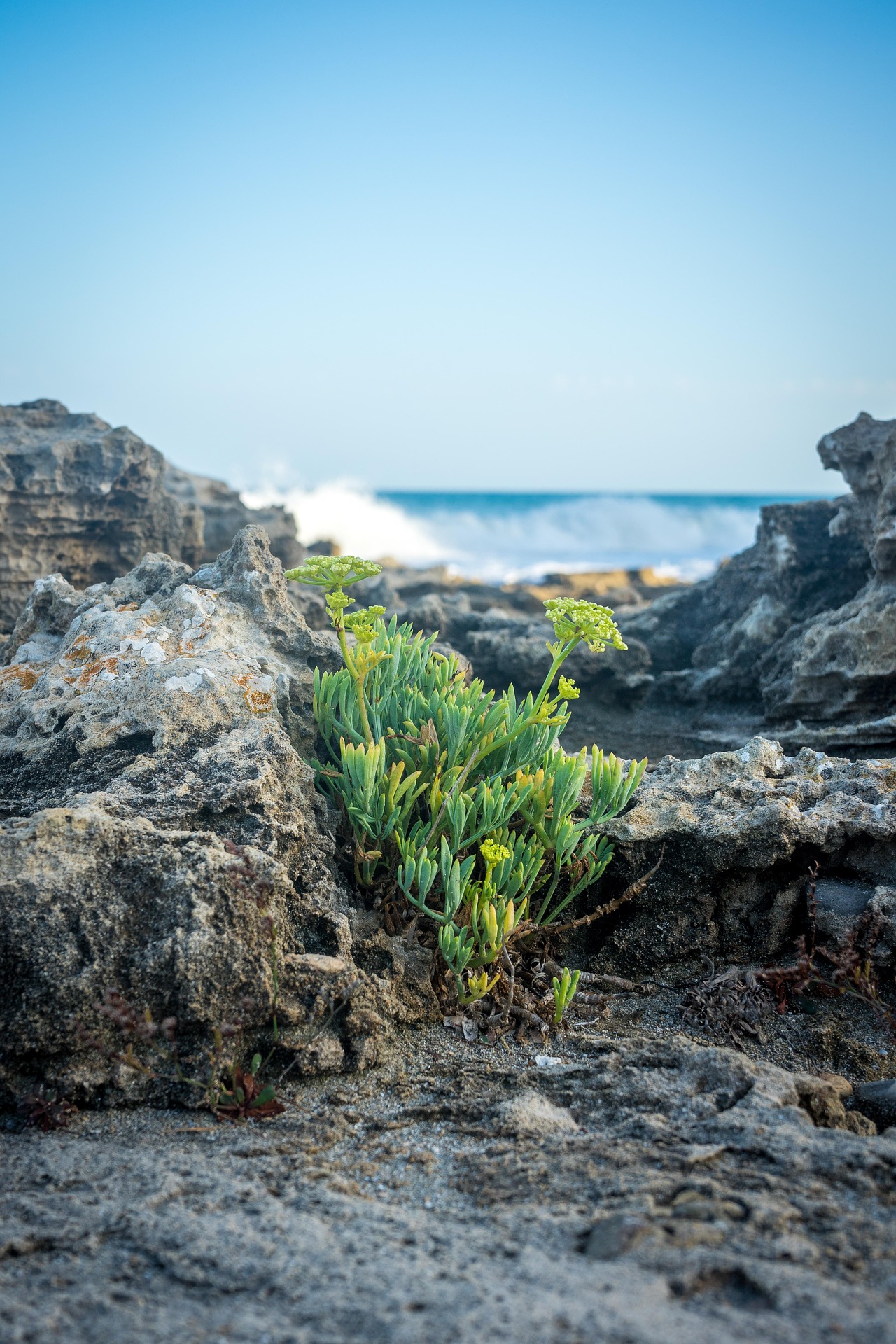
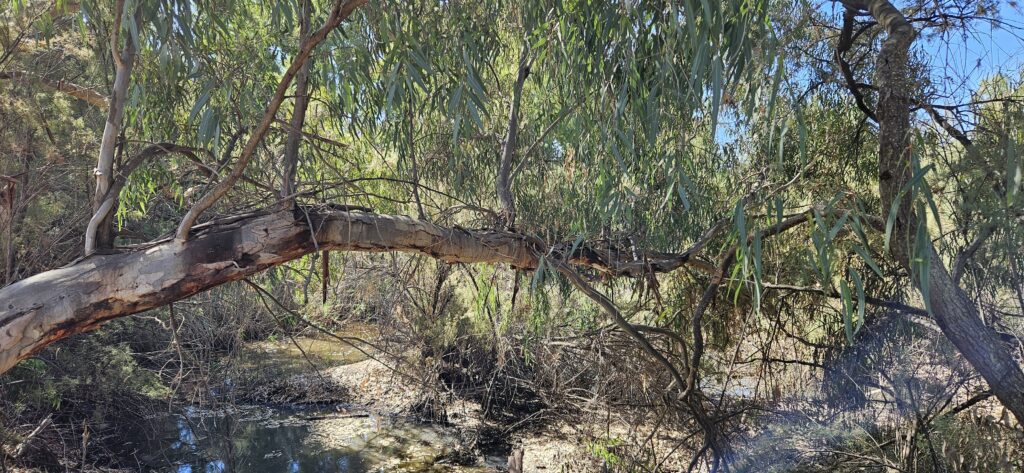
Eucalyptus Tree
In Sardinia, the slender, tall eucalyptus trees (Eucalyptus) with their long, silvery-green leaves are especially found in wetter regions and former marshlands. They also shape many coastal areas. Originally, they did not come from the island but were introduced from Australia in the 19th century. With their high water consumption, they helped drain once extensive wetlands and marshes, making the land more habitable for people.
Eucalyptus is mainly known as a valuable medicinal plant. Its leaves contain essential oils with antiseptic, anti-inflammatory and expectorant properties. Traditionally, they are used for colds, coughs, or muscle tension, either as tea, inhalation, or massage oil. Eucalyptus also has a firm place in cosmetics: the oil is used in soaps, creams, and bath products because it refreshes, invigorates the skin, and is often included in products for blemished skin.
Fig Tree
We loved sitting under its shady branches and feeling the calm radiating from this ancient plant: in Sardinia, fig trees (Ficus carica) are found not only in many gardens but also along roadsides and in rural landscapes. They are perfectly adapted to the Mediterranean climate: drought-resistant, undemanding, yet rich in succulent fruits. Especially in summer and early autumn, the branches are laden with sweet, honey-like figs that attract not only humans but also birds and insects feeding on the fruit.
Many fig species, particularly wild figs, have a special relationship with wasps: the tiny insects enter the fruit to lay their eggs, simultaneously pollinating the fig flowers. While crawling into the narrow openings of the fruit, their wings may be damaged, preventing them from leaving the fruit. For humans, the figs are still edible, as the wasps decompose within the ripe fruit.
Interestingly, the flowers are located inside the fig – tiny, inconspicuous, and inward-facing. The juicy, fleshy part we eat is actually the greatly enlarged ovary that encloses the flowers.
The fig tree has a long history on the island: even in antiquity, it was valued for its fruits and nutrient-rich wood, which enriches the soil as it decomposes, enhancing the fertility of the surrounding area. In mythology, the fig symbolizes fertility, prosperity and wisdom – the ancient Greeks and Romans even revered the tree in ritual practices.
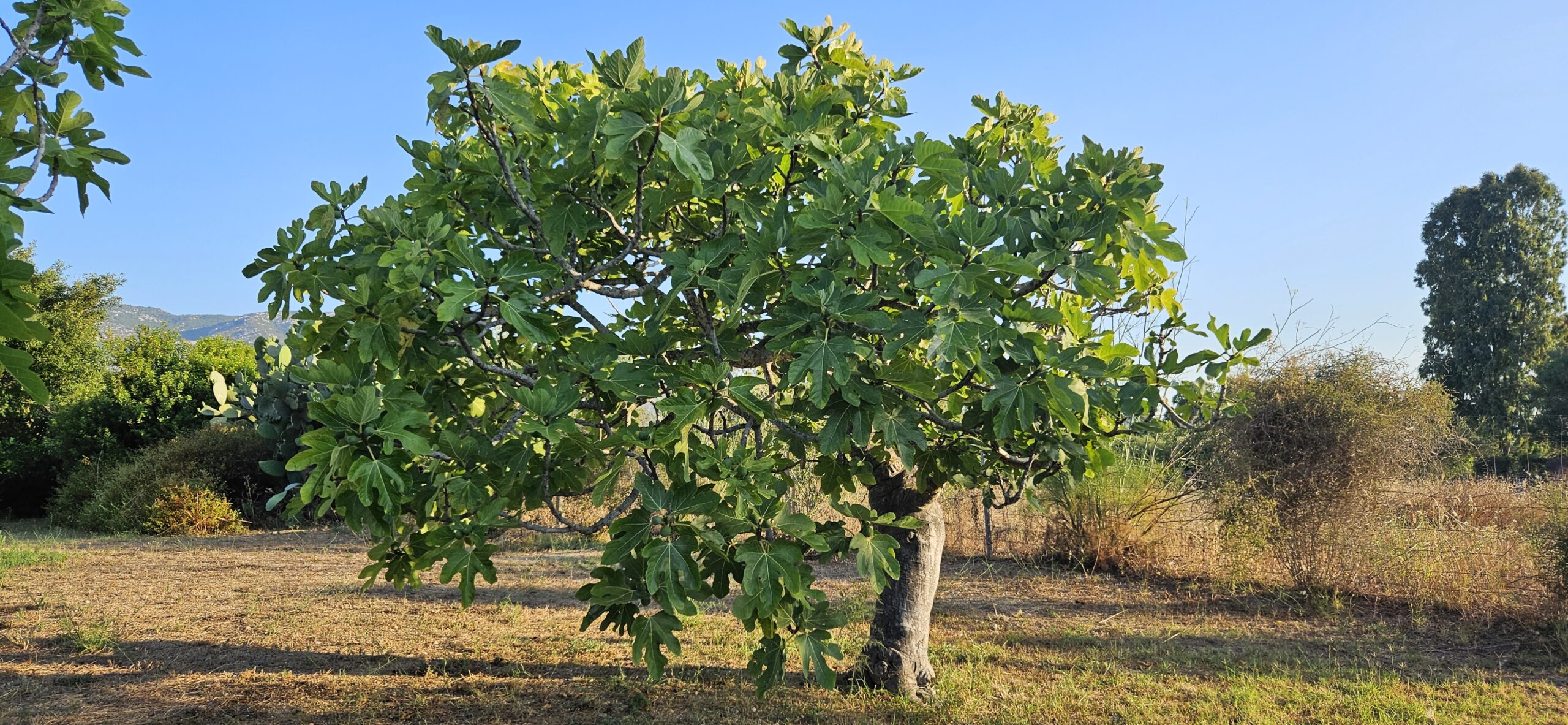
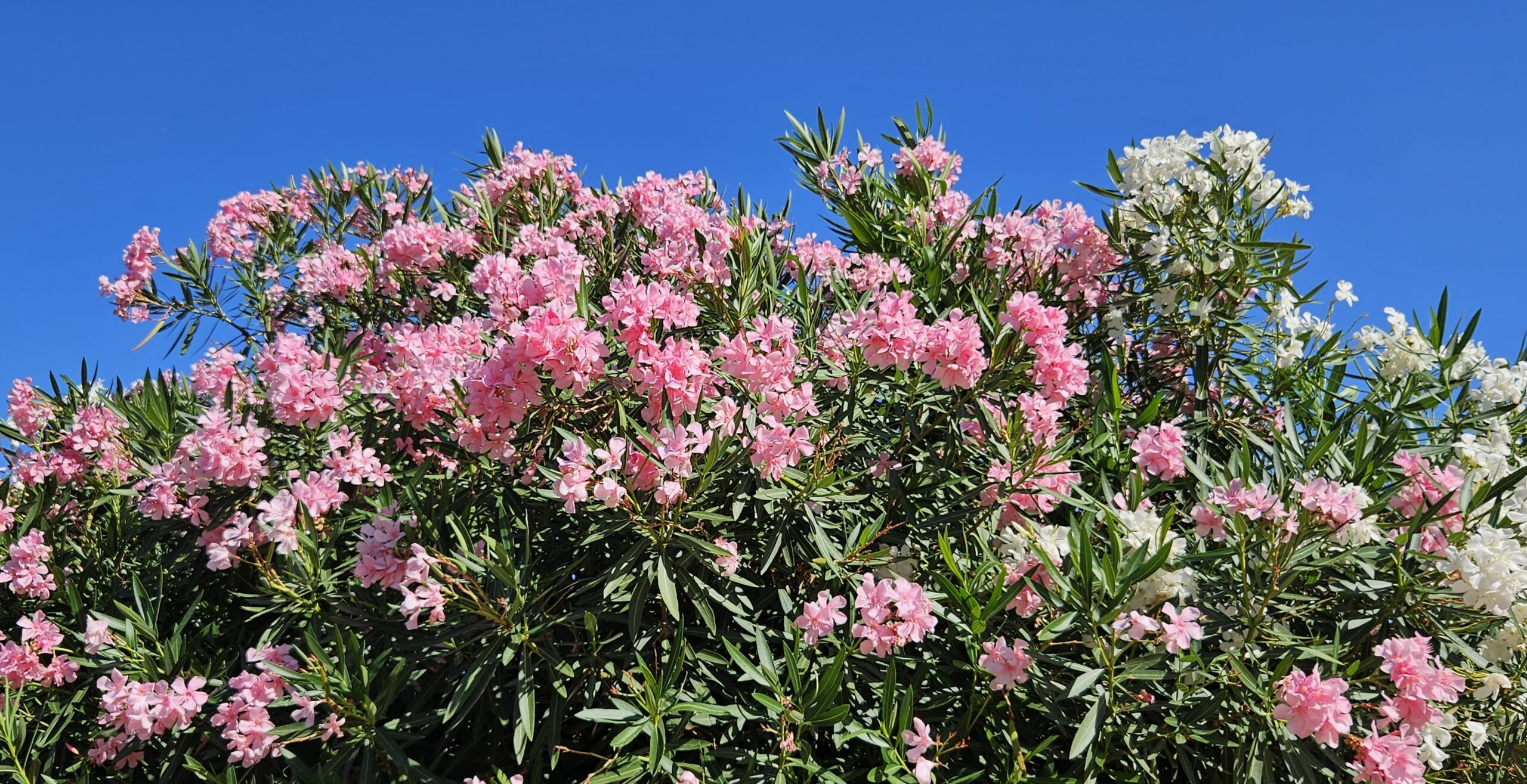
Flowering Shrubs
Sardinia’s landscape is shaped not only by maquis, coastal and beach plants but also by lush flowering shrubs that make the island glow with vibrant colors, especially in spring and summer. Oleander and jasmine are particularly characteristic of the Mediterranean flora.
Oleander (Nerium oleander) produces dense clusters of flowers in white, pink, or bright red. It often grows along roadsides, in gardens, or along coastlines and tolerates heat, drought, and salty air very well. Oleander symbolizes beauty and resilience in Mediterranean culture, while also serving as a warning: all parts of the plant are poisonous.
Jasmine (Jasminum officinale) impresses with its white, fragrant flowers, which release an especially intense scent in the evenings. In Sardinia, jasmine is valued not only as an ornamental plant but also for perfumes and traditional flavorings. Symbolically, jasmine represents purity, sensuality and joy.
Both shrubs contribute significantly to biodiversity: they provide nectar for bees, butterflies, and other insects, enriching the ecosystem.
Juniper
In Sardinia, juniper is mainly found in the mountainous regions and on dry, rocky soils. Its silvery-green needles and aromatic berries make it a striking feature in the landscape.
Two main species occur on the island:
- Common juniper (Juniperus communis): Found mostly in cooler mountainous regions, rarely at lower elevations. Grows as a shrub or small tree, with soft, pointed needles and small bluish-black berries. The berries are aromatic, with a low resin content.
- Prickly juniper (Juniperus oxycedrus): Typical of dry, sunny, and rocky areas. Grows as a dense shrub or small tree, with stiff, pointed needles and larger, resinous-aromatic berries. This species is traditionally used for liqueurs and medicinal purposes.
Juniper has been valued for its health benefits for centuries: the berries, a popular spice, contain essential oils with diuretic, anti-inflammatory, and digestive-promoting properties. Traditionally, they have been used both in folk medicine and in the production of liqueurs, such as the well-known Sardinian juniper schnapps.
Historically, juniper is deeply rooted in Sardinia. Archaeological findings show that the Nuragic culture already used it – likely for medicinal purposes, fumigations, and as a protective plant. In European folk and medieval mythology, juniper was considered a symbol of protection, purity, and the warding off of evil spirits. In Celtic, Germanic, and later Christian traditions, it was used to safeguard houses, stables, or people from illness and misfortune.
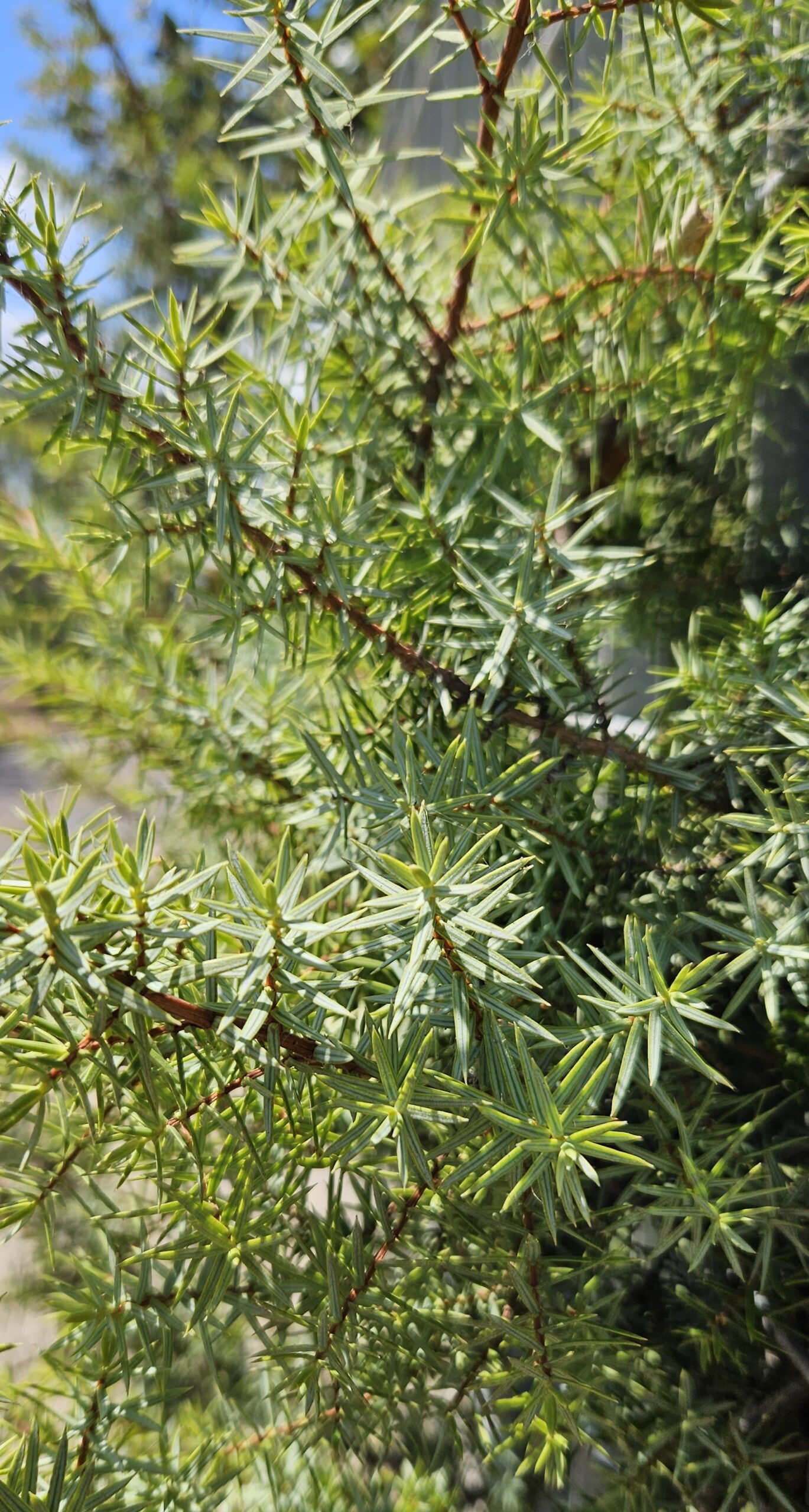
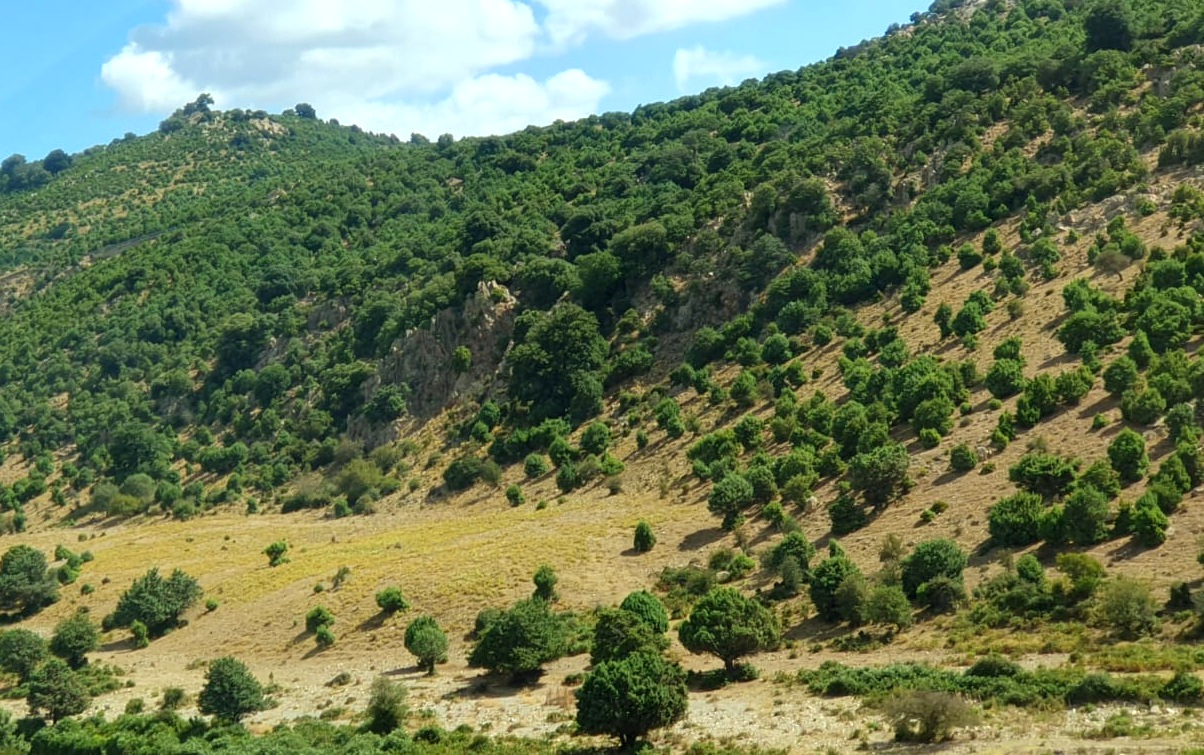
Maquis
The maquis is a dense, evergreen shrubland typical of the Mediterranean climate. This ecosystem covers large parts of the island and is composed mainly of aromatic and hardy herbs and shrubs that tolerate dryness, sun, and windy conditions well. Typical plants of the maquis include rosemary, thyme, rockrose, myrtle and mastic. Tree species found within the maquis are holm oak, cork oak, strawberry tree and olive.
The maquis is not only a botanical highlight but also an ecological powerhouse: it stabilizes the soil, provides food, shelter, and habitat for birds, reptiles, and insects, and shapes Sardinia’s landscape with its intense green and silvery hues. A walk through these fragrant, wild shrubs is a true feast for the senses!
Mastic
The evergreen mastic shrub (Pistacia lentiscus) is also called wild pistachio, as it is botanically closely related to the cultivated pistachio (Pistacia vera). For centuries, the mastic shrub has shaped the Mediterranean landscape of Sardinia. It can grow up to 2-3 meters high and, under optimal conditions, can take on tree-like forms reaching up to 6 meters. In Sardinia, it usually grows as a bushy, densely branched plant because the sites are often poor and dry.
Its aromatic resin, called mastic, was already valued in antiquity by the Phoenicians, Greeks, and Romans as a medicinal remedy, spice, and valuable trade commodity. It is obtained by carefully scoring the branches: the exuding resin hardens in the air and is then collected. It is considered anti-inflammatory, antibacterial, and beneficial for the stomach and digestion. Traditionally, it is also used for oral hygiene or incorporated into liqueurs and cooking.
From this hardened resin, mastic essential oil can be extracted through distillation or other methods, containing the same health-promoting compounds as the resin. This oil is mainly used in aromatherapy, cosmetics, and pharmaceutical products. The leaves also contain essential oils, though in smaller amounts, and are occasionally used as tea or seasoning, with mild digestive or calming effects.
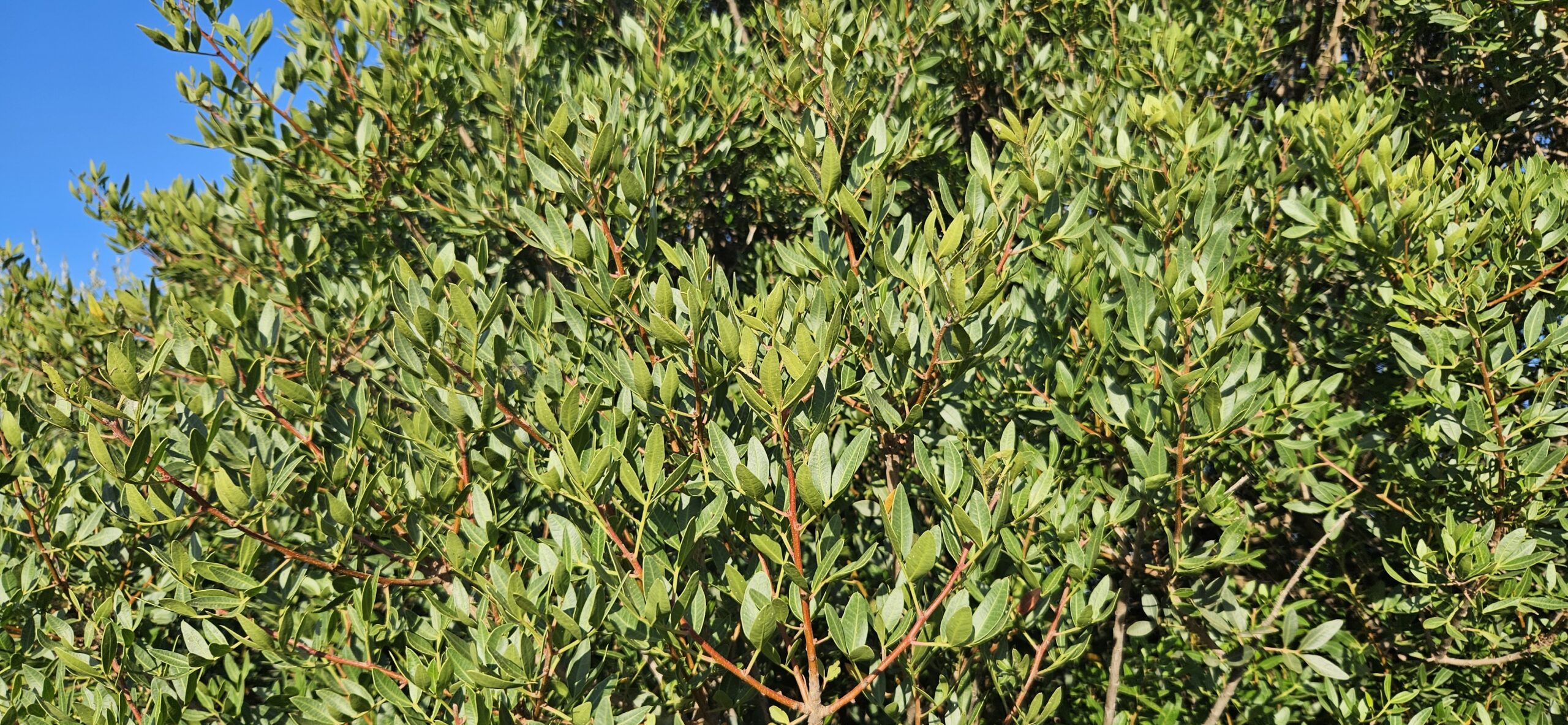
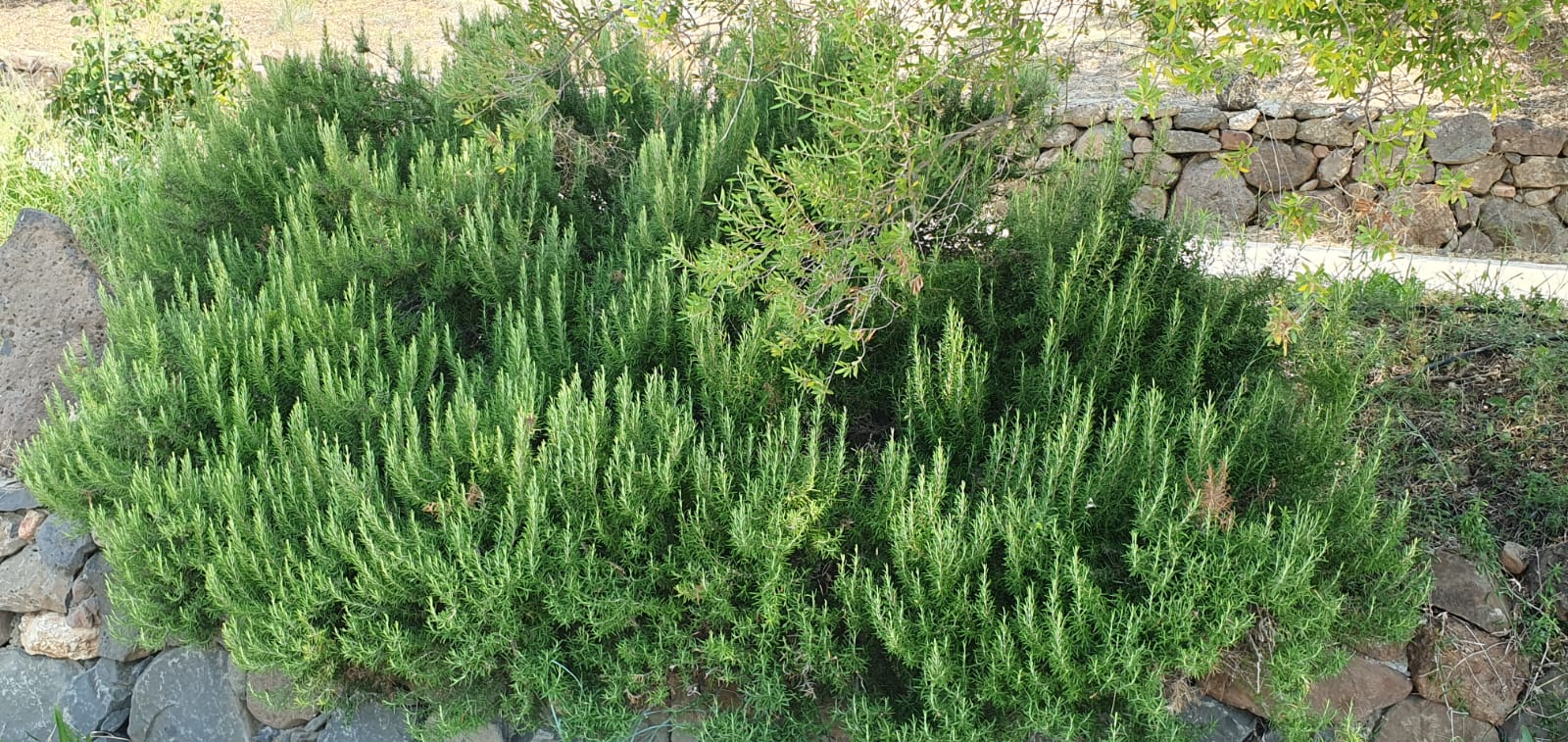
Mediterranean Herbs
Among the true treasures of the island are its diverse aromatic herbs, which thrive on the sunny hills of the maquis. Between the rocks grow fennel, lavender, bay, mint, oregano, rosemary, sage, thyme, and lemon verbena. They are perfectly adapted to the harsh, dry climate: they store water in their leaves, withstand sun and wind, and at the same time provide food and shelter for insects and birds.
These intensely fragrant and flavorful herbs have been used by the local population for centuries: as spices in cooking, as medicinal plants, or for aromatic oils. Fennel, mint, and sage are traditionally valued as teas or remedies, while rosemary, thyme, oregano, and bay enrich Sardinian cuisine with their savory aroma. Lavender and lemon verbena are used in teas, cosmetics, and aromatherapy.
Mediterranean Strawflower
The Mediterranean strawflower (Helichrysum stoechas) grows in Sardinia on dry, sunny soils, primarily in maquis formations and on sunlit coastal slopes, and less frequently directly in the dunes. Its silvery-gray, woolly leaves protect the plant from drying out due to sun, wind, and salt spray, which draws water from the plant cells.
The plant is also known in French and in common usage as Immortelle (“immortal”). The name comes from the fact that the flowers are long-lasting and largely retain their shape and color even after drying.
Its small yellow flower heads appear from April to July. The leaves are aromatic and emit a spicy, curry-like scent, which is why the plant is sometimes called “curry herb”. Botanically, however, it does not belong to the curry spice and is not suitable for consumption.
There is a second species, Helichrysum italicum, which also occurs in the Mediterranean. It is more commonly used as curry herb, is edible, and is cultivated, but it does not grow as frequently in the wild on Sardinia as Helichrysum stoechas.
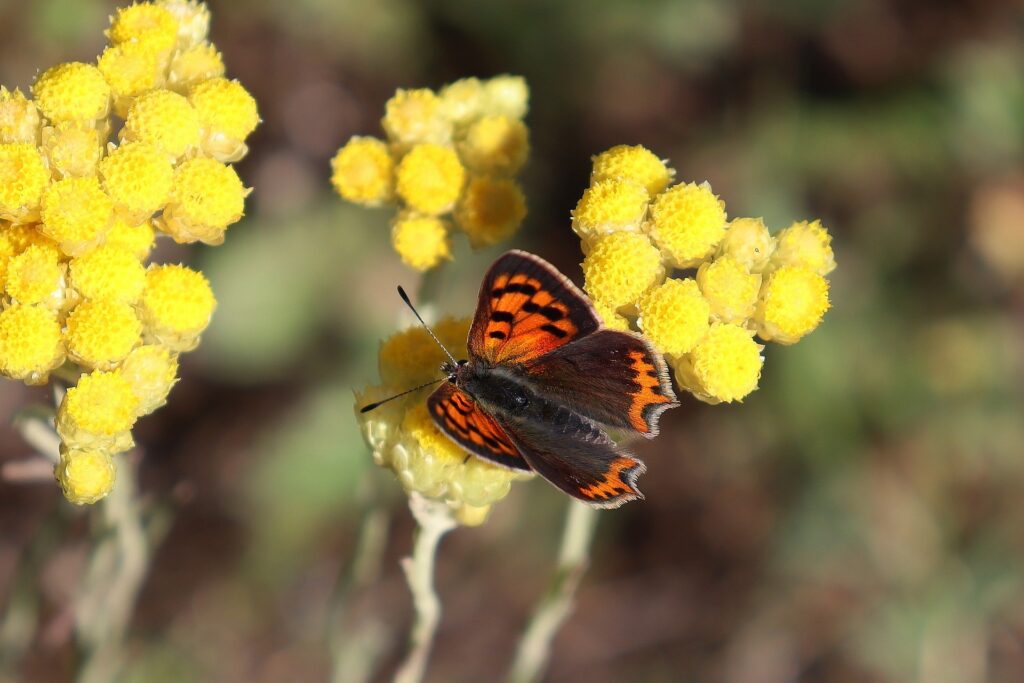
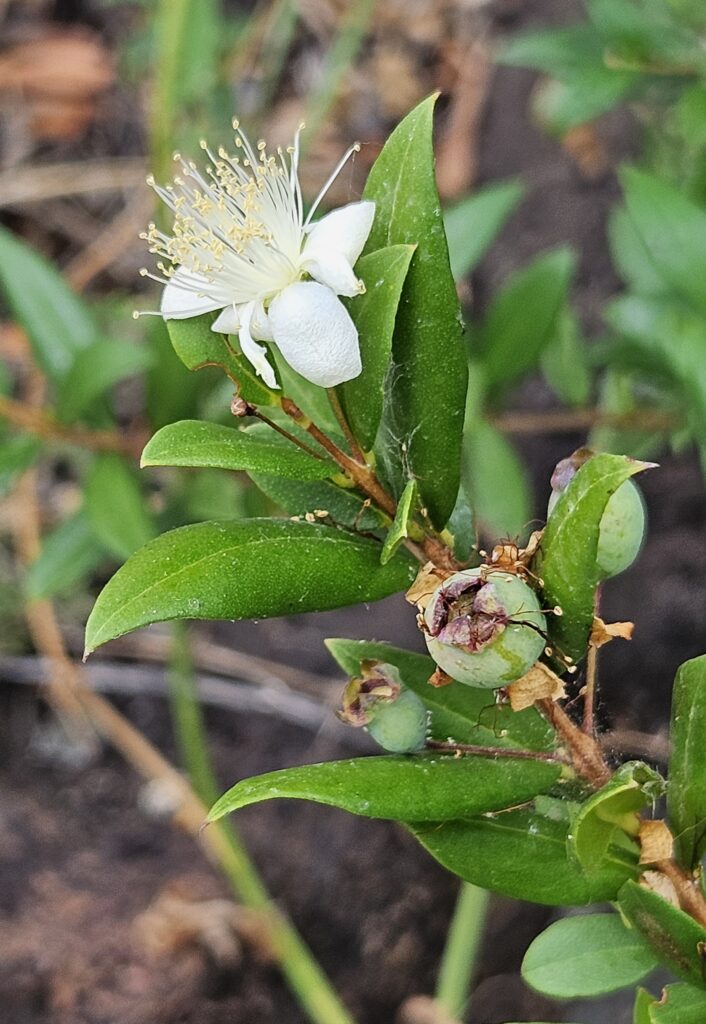
Myrtle
The myrtle (Myrtus communis) is an evergreen shrub typical of Sardinia’s maquis. The plant has traditionally held great significance:
For health, it is valued for its antibacterial, anti-inflammatory, and digestive-promoting properties. Since antiquity, people have used its leaves and berries for ritual purposes, remedies, and as a spice. Today, these plant parts are used in teas, extracts, and essential oils, which find applications in natural medicine, aromatherapy, and skincare. In particular, the dark violet to blue-black berries, as well as the leaves and white flowers, are used to produce the famous Sardinian liqueur Mirto, available in both red and white varieties.
Myrtle also played a role in mythology: it was sacred to the goddess Aphrodite/Venus and symbolized love, purity and fertility. This cultural significance is still reflected today in rituals, wedding bouquets, and traditional uses.
Oak Tree
The oak is one of the most prominent trees in Sardinia. Two species are particularly widespread: the holm oak (Quercus ilex), an evergreen tree perfectly adapted to hot, dry conditions, and the cork oak (Quercus suber), known for its thick, peelable bark – the outer protective layer of the trunk, which is harvested and used as cork.
For centuries, oaks have been used in many ways by the people of Sardinia. Cork oaks provide the important wine cork, while holm oaks have traditionally served as firewood and construction timber. Today, Sardinia is one of Europe’s leading cork producers, and cork oak forests shape the island’s landscape in many regions.
Cork oak forests are also ecologically valuable, as they prevent erosion and promote biodiversity. Oaks provide habitats for numerous animals, from birds and insects to small mammals. Acorns, the fruit of the oak, are an important food source for many species.
In European mythology, the oak symbolizes strength, longevity and protection. In antiquity, it was sacred to the god Jupiter, while in Celtic and Mediterranean cultures, it represents wisdom and steadfastness.
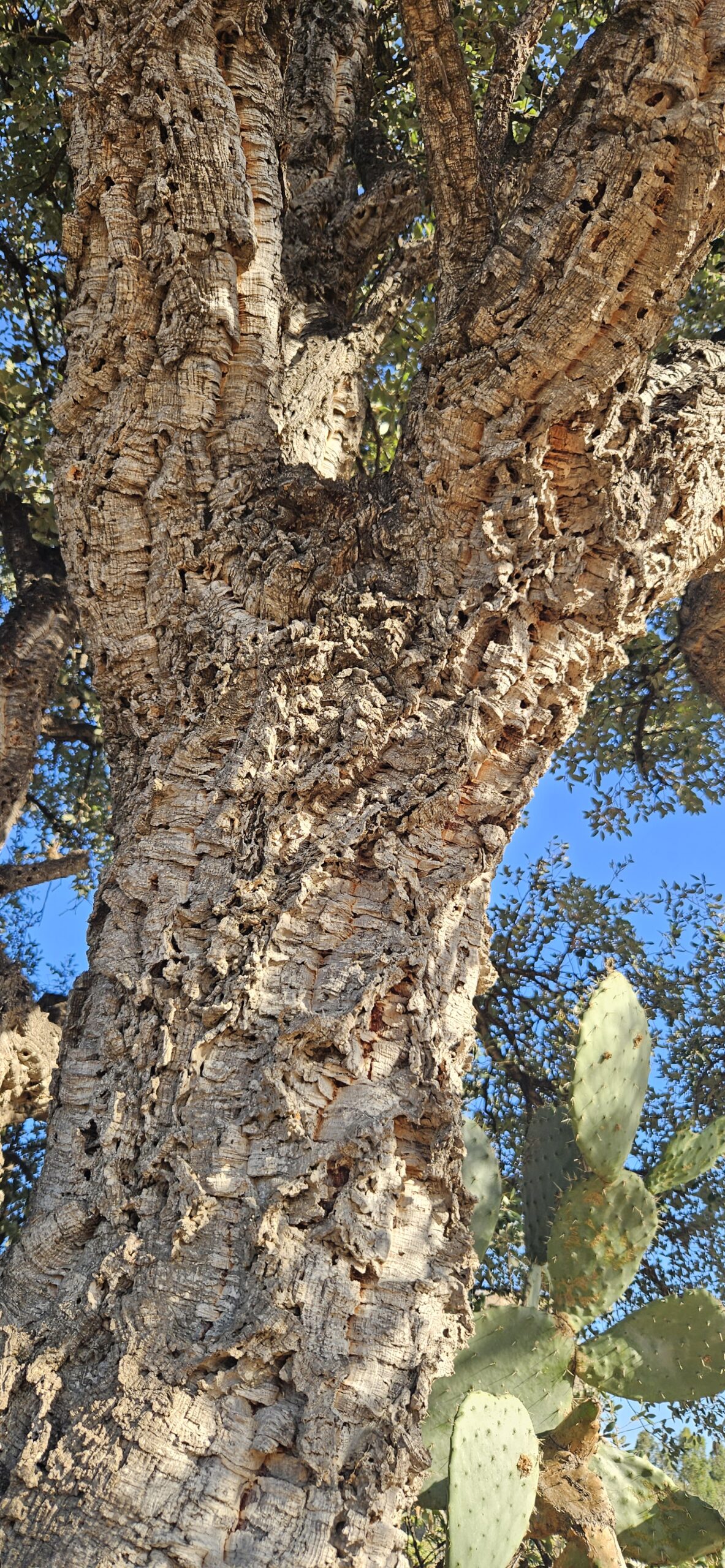
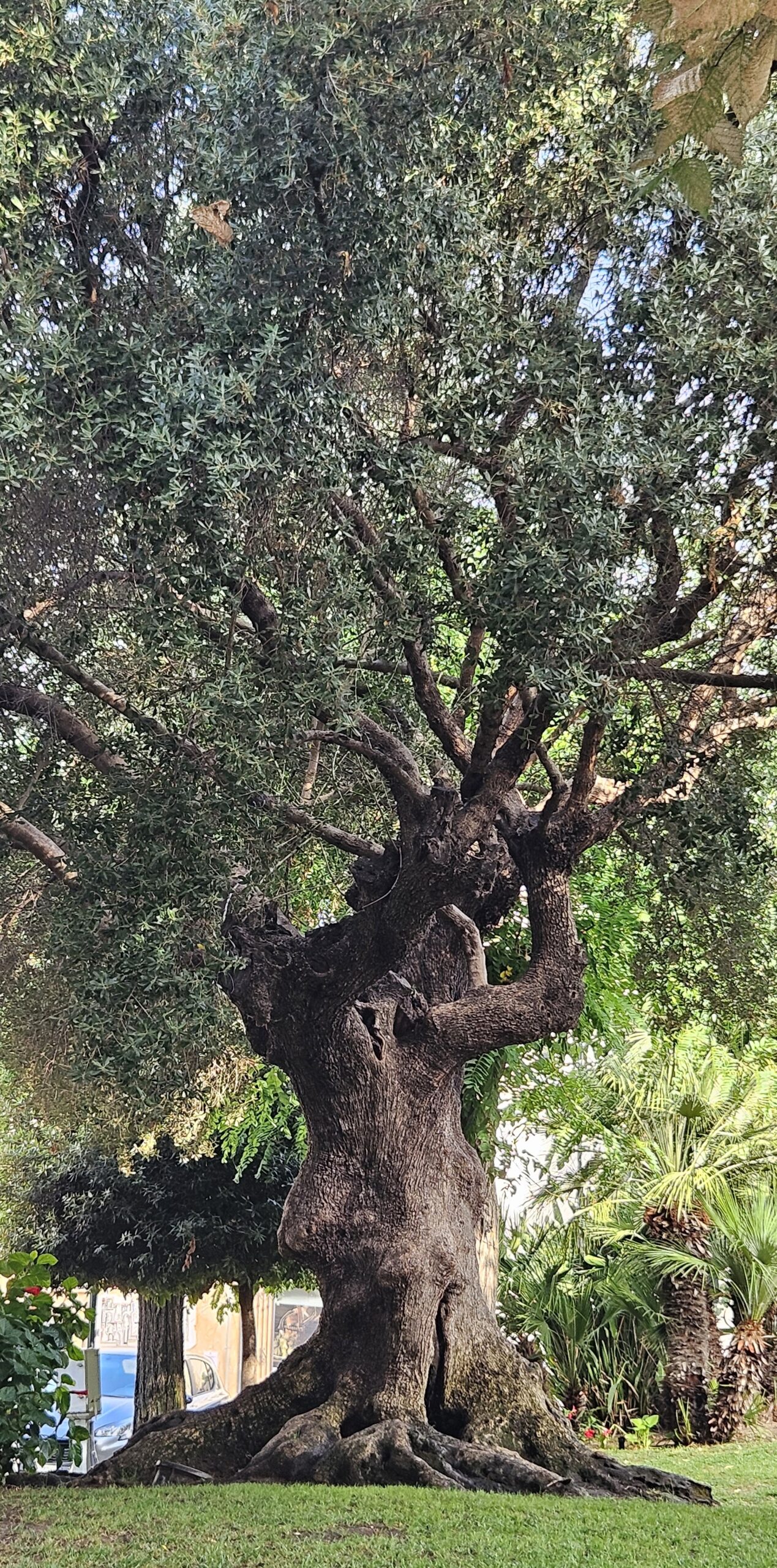
Olive Tree
Sardinia is renowned for its ancient olive groves, some of whose trees are several hundred years old. These resilient plants (Olea europaea) thrive even under wind, drought, and salty sea air, shaping the island’s landscape with their silvery-green leaves and gnarled trunks.
Olives and their oil are not only a culinary highlight but also a health marvel. Rich in monounsaturated fats, antioxidants, and polyphenols, they support heart and circulatory health, aid digestion, and have anti-inflammatory effects – one reason why the Mediterranean diet is so highly regarded.
Historically, the olive tree is deeply rooted in Sardinia: the Nuragic culture and later the Romans used olive oil for nutrition, medicine, and ritual purposes. Many of the olive groves that still exist today are living witnesses to this long tradition, uniquely connecting nature, culture and history.
Pine Tree
The Mediterranean coast of Sardinia is marked by majestic stone pines (Pinus pinea), whose characteristic dark green umbrella-shaped crowns provide shade and define the island’s landscape. These trees are well adapted to the Mediterranean climate, withstanding heat, drought, and salty sea air.
Pine nuts, the edible seeds of the tree, are not only a culinary delicacy but also healthy: they contain beneficial fats, proteins, minerals, and antioxidants that support heart and circulatory health and strengthen the immune system.
Historically, the pine tree has also played an important role in Sardinia. Since antiquity, people have used pine wood for construction, shipbuilding, and tools. Pine nuts were traded and have long been considered a valuable food supplement.
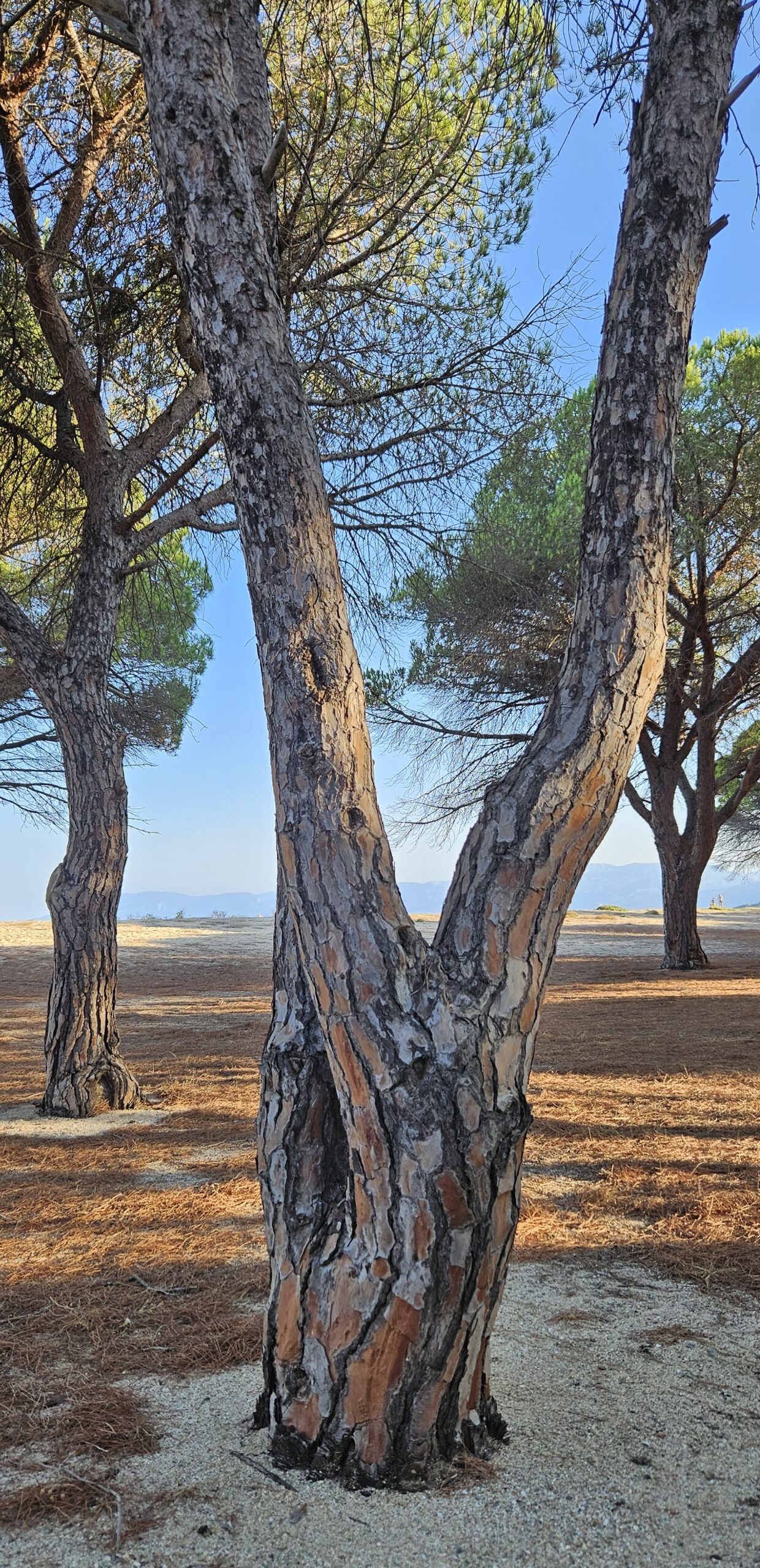
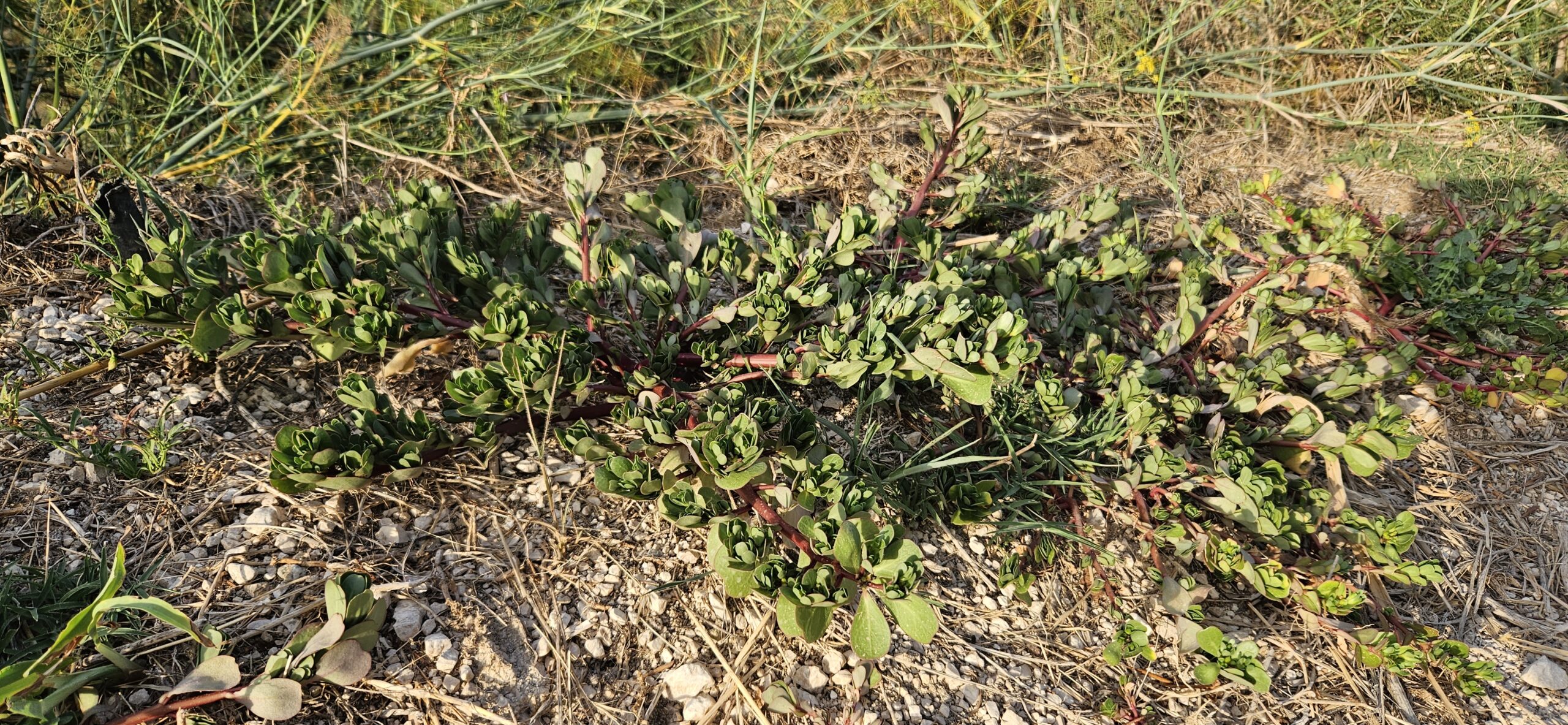
Purslane
Purslane (Portulaca oleracea), also known as garden or summer purslane, has been valued on the island for centuries. Thanks to Sardinia’s mild climate, it grows easily and robustly. We often found it along roadsides. Today, it is often overlooked – but it is more worthwhile than ever to bring this fleshy, healthy vegetable herb back to the plate: locally growing and with its distinctive, slightly nutty flavor, purslane is full of valuable nutrients such as omega-3 fatty acids, vitamins and minerals.
Rockrose
Anyone hiking Sardinia’s sunny hills and coastal stretches will inevitably encounter the rockrose (Cistus). This evergreen shrub is a typical representative of the maquis and perfectly adapted to the island’s dry, windy climate. Its gray-green, woolly leaves store water and protect the plant from drying out, while its pretty white to pink or violet flowers brighten the landscape with delicate splashes of color in spring and summer.
The rockrose is not only a visual highlight: its leaves are rich in polyphenols and essential oils, traditionally valued for their health-promoting properties. As a tea or extract, rockrose supports the immune system, acts as an antioxidant, and can help the body combat free radicals. In this way, the shrub uniquely combines the beauty of Sardinian nature with natural health benefits.
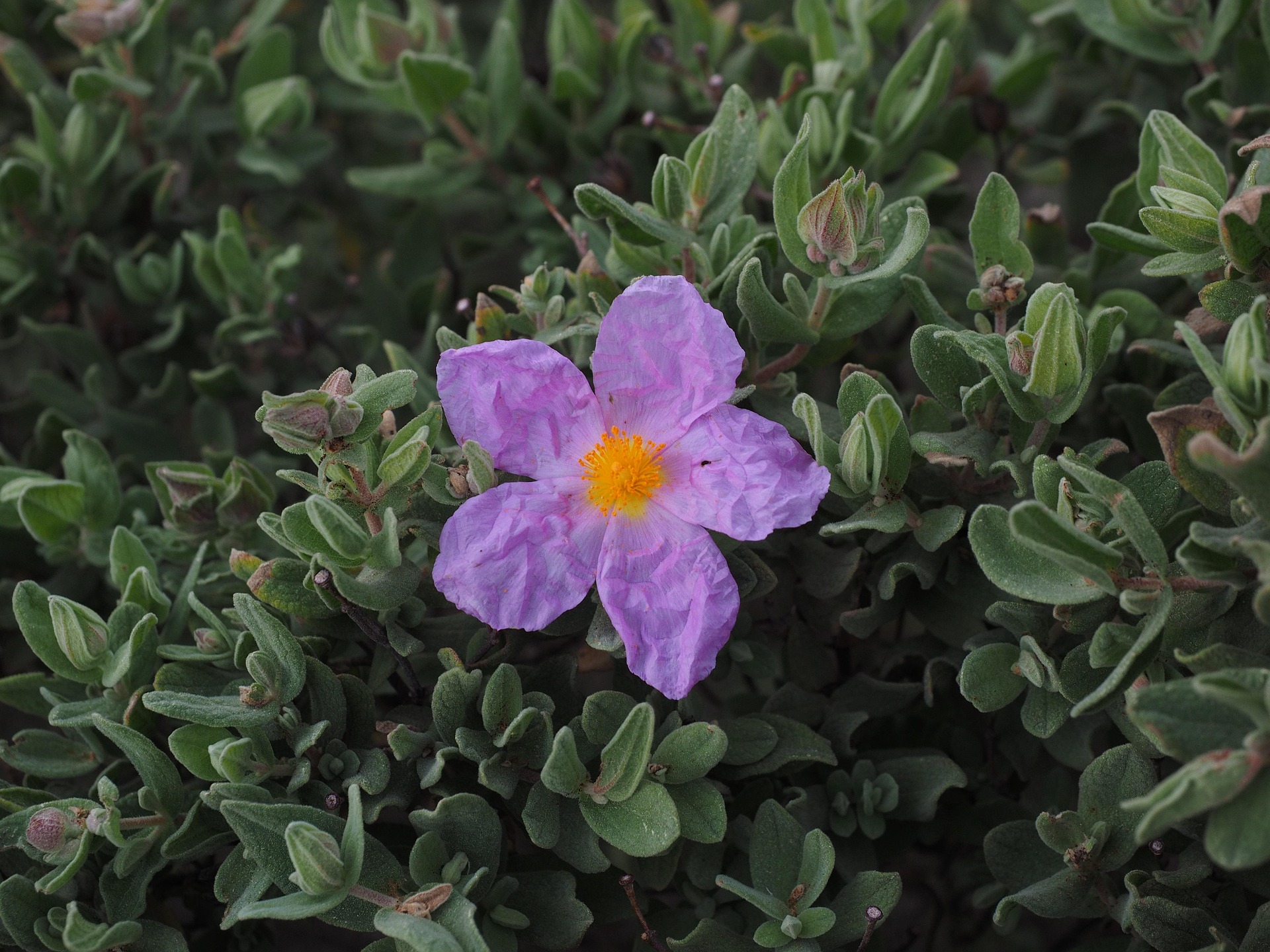
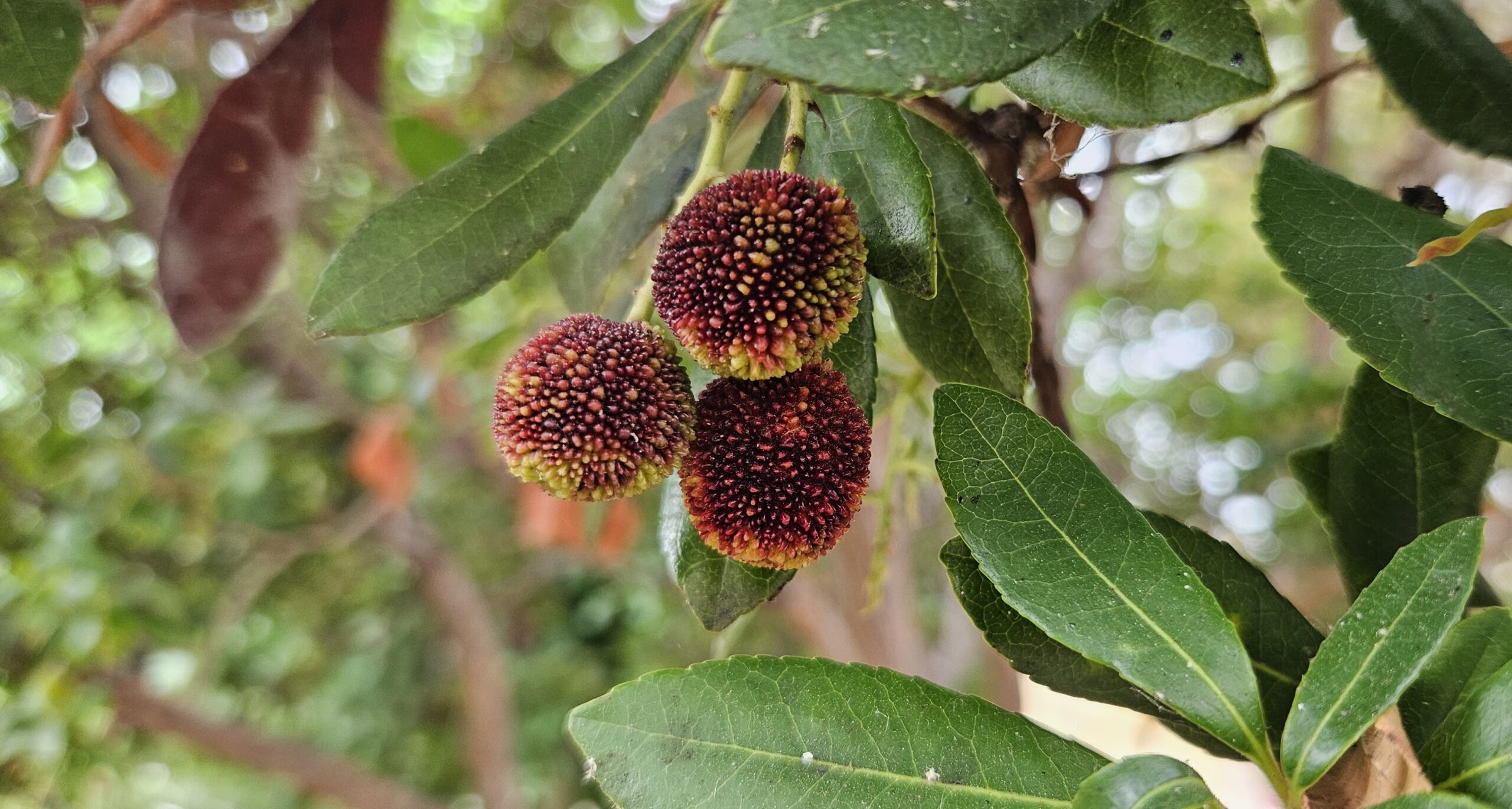
Strawberry Tree
In Sardinia, one often encounters a small, inconspicuous tree with bright red fruits in autumn: the strawberry tree (Arbutus unedo). Its name comes from the appearance of the fruits: they are round to slightly oval, red to orange, with a rough, dotted surface reminiscent of strawberries. Botanically, the strawberry tree is not related to the strawberry; they belong to different plant families.
The fruits are sweet but not very juicy or intensely flavored. They are usually eaten individually or processed into jam, liqueur, or purée. The botanical name unedo, Latin for “I eat only one,” refers to this characteristic.
Even in antiquity, people valued both the fruits and the hard wood of the strawberry tree, which was used for tools and small furniture. The tree’s bark is also striking: reddish-brown and peeling in thin, paper-like strips, making the tree recognizable even when it bears no or unripe fruits.
In ancient Greece, the evergreen strawberry tree was a symbol of immortality and fertility. Its red fruits, ripening in winter, were seen as a sign of life amid barren landscapes. In Sardinian folklore, the tree is also associated with luck and protection, especially when growing near villages.




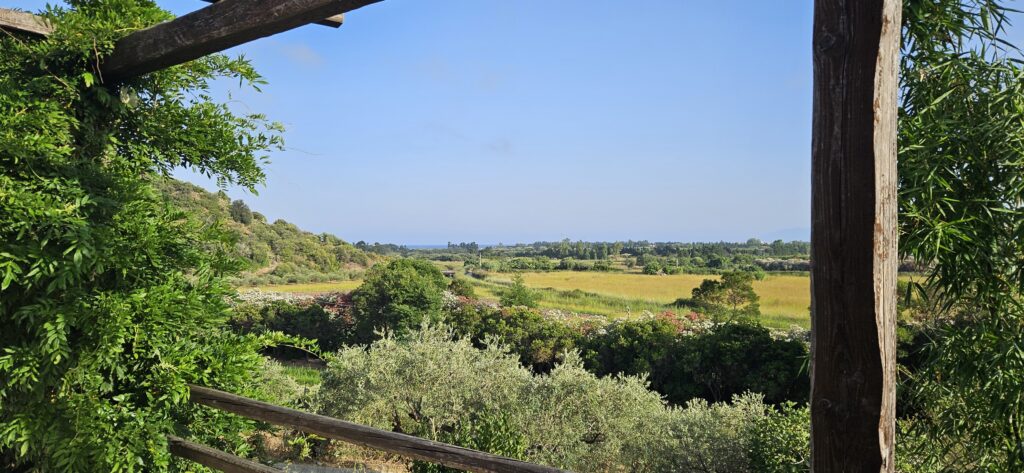
Leave a Reply